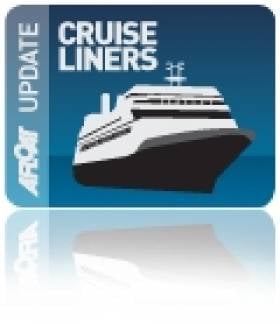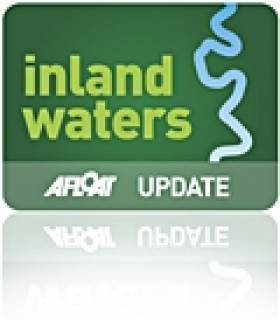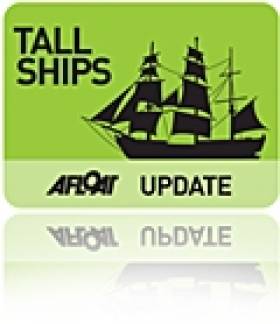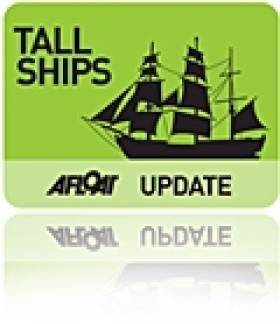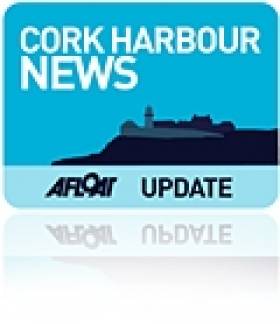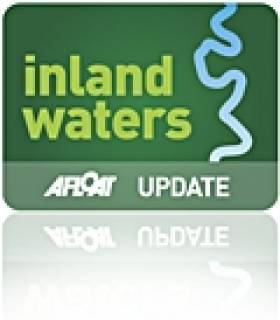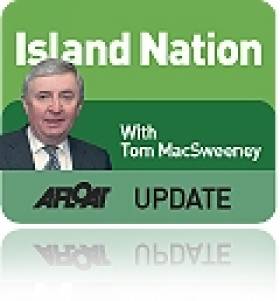Displaying items by tag: Ireland
Cruise Line Business Worth €60m
There are many indirect economic and tourism benefits to Ireland from this sector, as well as the benefit of introducing Ireland to new markets and business opportunities. Such cruise visits also help to showcase Ireland's world class shore products, destinations and highlights all that Ireland has to offer visitors.
One of Ireland's advantages is the strategic and geographic spread of its numerous ports, many of which are in close proximity to world class tourism destinations.
Speaking at Seatrade Miami this week, the Chairman of Cruise Ireland, Mr Brendan Keating said "Cruise Ireland aims to promote the island of Ireland as an excellent cruising ground for cruise companies. With the total economic contribution of €60 million, we need to ensure that Ireland maintains this level of business and looks at methods of growing it in the future."
He continued; "Cruise Ireland is looking forward to the 2011 season with confidence. We expect to see further growth in ship calls and the continued establishment of Ireland as an important cruise liner destination. Marketing Cruise Ireland at Seatrade will hopefully encourage further cruise bookings to Ireland in 2012 and 2013."
Representatives from Cruise Ireland attended Seatrade Miami to promote the Island of Ireland as a cruise line tourism destination. This event is attended by over 10,000 delegates, cruise line operators, the world's leading cruise tourism destinations and 118 countries.
Each year, all of the international operators including Princess Cruises, Royal Caribbean, Cunard, Holland America Line and NCL visit Irish ports to access Ireland's world class destinations.
The 2011 season will kick off in early April with calls by the MV Queen Victoria to Cork, the MV Boudicca to Dublin and the MV Ocean Nova to Belfast
Masters are requested by Waterways Ireland to give the parade a wide berth if not participating in it and to proceed at slow speed and with minimum wash when passing and to heed any advice offered by parade marshals.
A Tall Ship for Ireland? - Poll
Should Ireland be represented at the Tall Ships Races at Waterford 2011 and Dublin 2012? We want your vote on our Facebook Poll HERE.
Looking for further reading on Tall Ships in Ireland? Click the links below:
Click this link to read all our Tall Ships Stories on one handy page
Previewing Ireland's Tall Ships 2011 Season
Can Ireland Get a New Tall Ship?
2011 Irish Coast Sailing Directions Published
The Irish Cruising Club's acclaimed Sailing Directions, in two volumes, offer comprehensive coverage of the entire coast of Ireland, and their price has recently been reduced by £10.00 to £27.50 each (€32.50).
These are the only cruising guides for the Irish coast to be frequently and comprehensively updated, with corrections available free at www.irishcruisingclub.com.
The 310 page South and West volume was reviewed in Cruising magazine, Sept 2010: "If you are intending to cruise these coasts, or even if you are only thinking of doing so, it is essential. As Sailing Directions they are well-nigh perfect."
Written, edited, designed and printed on the island of Ireland, these handsome hardback books are carried as an aid to navigation and pilotage by the Irish Naval Service, the Irish Coast Guard and the Commissioners of Irish Lights, and they are used as a reference source by the UK Hydrographic Office.
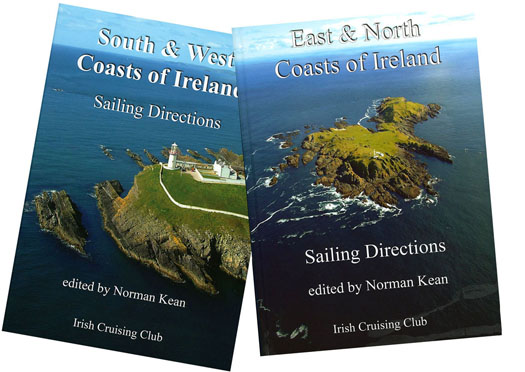
ICC SDs are available from chandlers and booksellers, and are distributed in Great Britain and the rest of the world by Imray, and in Ireland by Todd Chart Services. East and North Coasts Directions ISBN 978 0 9558 199 1 9; South and West Coasts Directions ISBN 978 0 9558 199 2 6.
Tall Ship Interests Plan Replacement for Asgard II
Ireland could yet have a Tall ship to replace the Asgard II and the Lord Rank, if a new sailing group formed to press for a replacement is successful. The news is in this morning's Irish Times newspaper. Groups representating different interests from maritime to tourism to economic are getting together for a special conference on March 26th in Dublin Port. The full Irish Times story is HERE. Next week in Afloat magazine's March/April issue an article called 'Tall Order for Ireland' gives all the details on the conference. It includes a 'call for contributions' from key stakeholders who would support a Tall Ship for Ireland. More details HERE. And in a separate article WM Nixon looks at the realities of national sail training in the 21st Century. This new move on a replacement seems to have entirely appropriate timing; Asgard II was commissioned in Arklow 30 years ago this week, on March 7, 1981.
Looking for further reading on Tall Ships in Ireland? Click the links below:
Click this link to read all our Tall Ships Stories on one handy page
Previewing Ireland's Tall Ships 2011 Season
Can Ireland Get a New Tall Ship?
O'Shea Fourth in Moth Worlds Silver Fleet
Ex-Pat Michael O'Shea has finished fourth in the silver fleet of the Moth world championships staged in Belmont, Australia.
The class promises to be the next hot thing because of its high speed through the use of foils that keep the hull clear of the water. The class has yet to be established in Ireland.
The Cork sailor set a personal best of 27.5 knots (10 second average) in one of the races.
O'Shea, a former 49er and Hobie 18 sailor from Monkstown, is now living in Sydney and was the sole Irish competitor at the Moth event.
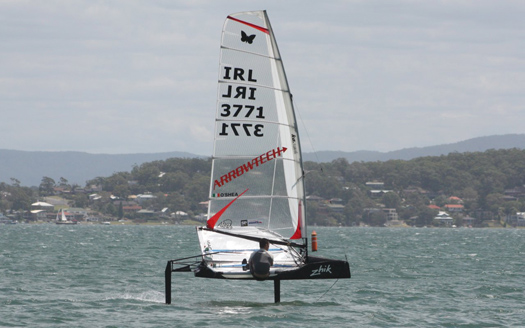
Michael has heard that heard there are a couple of boats in Dublin and is keen to help out anyone who is looking to get into the class with tips and tricks.
Watch the interview with Michael below. More pics of Michael HERE.
His next target on water is to try and hit 30 knots, not bad in a sailing dinghy! but his target ashore is to spread the word of these great advances back home.
"I'm looking to see if I can promote the class in Ireland and get some other sailors interested. The next worlds (2012) are in Lake Garda, somewhat easier to get to fro Ireland, he told Afloat.ie.
And it appears the boats are easily transportable- thanks to Ryanair - click HERE
Safety Precautions for Vessels and Crew
Owners and masters availing of winter mooring facilities for their vessels on any of Waterway Ireland's navigations are advised to choose a sheltered berth within the harbour, place adequate fendering between the vessel and the harbour wall and secure the vessel with double mooring lines.
The vessel should be monitored on a regular basis in the event that it should be taking or making water and particularly so after a period of stormy or frosty weather.
Owners visiting harbours during this period and who intend to work on their vessels should bear in mind the changed environmental conditions at this time of year and to take the appropriate measures necessary to reduce risks associated with working on or near water.
It is advised that personal protective clothing, to guard against the cold and the wet, including a personal flotation device, should be worn and all items checked for serviceability beforehand, bearing in mind:
• Low air temperatures
• Low water temperatures
• Reduced daylight
• Inclement weather
• Raised water levels
• Flood conditions including increased rates of flow
Working on or near water should preferably be undertaken in the company of a colleague. Lone working should be avoided if possible and especially at remote locations. Ensure that someone has been informed of your whereabouts and expected time of return.
Further, carry a mobile phone and/or a handheld Marine VHF, fully charged, for keeping in contact while being aware that full phone coverage is not available everywhere.
An Irish Maritime Foundation
I wonder whether there might be interest in forming an Irish Maritime Foundation?
I raise the question having discussed the possibility with those who run the UK Maritime Foundation and whose views about the sea about the sea impressed me when I met them in London. The Foundation traces its history back to 1981 when shipowners, senior retired naval officers and people involved in the financial industry reacted to changes in British Government policy that were regarded as failing to protect the importance of the UK maritime industry. It is a registered charity with the purpose of promoting and raising interest in the maritime sector amongst the public, the media and Parliament. To do so it is involved in assisting development of maritime education, training and research.
The British are a magnanimous people in my view. It was an honour to accept the Desmond Wettern Award from the Foundation. Desmond Wettern was a distinguished UK maritime journalist for over 30 years and the awards were established in his name. This year the Society for Nautical Research joined the awards project.
In responding I used one of my favourite descriptions - "the Family of the Sea," which I have used on radio. It drew a lot of interest from those present. I believe there is a "family of the sea" which spans oceans and seas, linking those who appreciate the sea as essential to human survival.
"Everyone who has an interest in the sea would recognise that there are and will continue to be, increasing pressures on its use and on the exploitation of its finite resources, but also a number of opportunities," according to Rear Admiral Christopher Perry, Chairman of the UK Marine Management Organisation. Those views and others I discussed with some of those amongst the 200 attending the function, who came from various parts of the world. Professor Richard Harding of the Society for Nautical Research which is marking its centenary, expressed this opinion: "There is a disturbing sense of sea-blindness in the British Government, amongst the general public at large and in the media."
There is certainly sea-blindness in our Government and in much of the media, though I am hopeful that there is growing awareness of the importance of the marine sector amongst the general public. If Ireland had an organisation like the Maritime Foundation, I would be very pleased.
• This article is reprinted by permission of the EVENING ECHO newspaper, Cork, where Tom MacSweeney writes maritime columns twice weekly. Evening Echo website: www.eecho.ie
Home Divers Make a Splash at Irish Open
Irish divers made a strong showing at the 2010 Irish Open National Championships last weekend.
Natasha McManus of the Dublin Diving Club took first place in the Girls C group 1 metre and 3 metre categories, just missing out on the platform dive by 15 points.
The Girls B+ 3 metre title went to Vivienne Hew, also of the Dublin Diving Club, Her sister Francesca took second place in the 1 metre category, setting a new personal best record.
In the Boys B+ group, the Shamrock Diving Club's Jack Ffrench won the 3 metre and platform categories - the latter helped by an unexpected dive from 7.5 metres that wowed the judges.
Fellow Shamrock diver Sean McCormack claimed the Boys B+ 1 metre title, while teammate Joshua Hernandez came third in the same category in the C group.
This was the biggest year yet for the contest at the National Aquatic Centre in Dublin, with 250 entries from diving clubs in Ireland, the UK and as far away as Italy.
Ireland Hold Overall Lead But 'Dark, Wet Night' Ahead
The 17.00 BST sched showed Anthony O'Leary's Antix second among the big boats, David Dwyer's marinerscove.ie second in the mid-sized fleet and Robert Davies' Roxy 6 second among the small boats. With these results the Irish team would be on 44.5 points ahead of France Blue and Hong Kong tied in second on 71.5. GBR Red holds fourth on 86.5, followed by France Yellow in fifth.
As conditions improved following a damp and misty start to the 180-mile offshore race in the Rolex Commodores’ Cup, the three boats representing the Irish Cruiser Racing Association are maintaining good position at the front of their respective classes as the fleet settles in for a long night of beating westwards.
Other boats have already retired from the race after the breezy start off the Royal Yacht Squadron in West Cowes at 10.30am local time today. A brisk passage eastwards with a favourable tide saw the lead change as the fleet remained bunched. After passing the forts off Portsmouth and into open water close to Bembridge Ledge, the bigger boats started to pull away.
The 28-boats are racing in wind against tide conditions on the course westwards to Poole Fairway buoy before the smaller boats retrace their route back to Cowes for an expected finish during Wednesday. The larger boats have their courses extended further westwards from Poole towards Swanage.

“They’re setting down solidly after a hectic start,” said Barry Rose, ICRA Commodore. “Antix came out of it quite well on the northern end of the line while marinerscove.ie and Roxy were in a lot of traffic at the busy leeward end of the line. They’re now in quite promising positions.”
At the team briefing this morning, skippers and navigators heard that a lot will happen overnight which will be decisive as a front is expected come through which could lead to a change in wind and conditions; this could prove critical.
On estimated results this evening, Ireland continues to hold the overall lead of the event with strong challenges emerging from both France Blue and Hong Kong.
The 30 strong Rolex Commodores' Cup fleet shot off east down the Solent this morning with the wind and tide but under a grey rain-filled sky at the start of their high points scoring offshore race. The course for the 10 teams is full of zigzags taking them first out towards Selsey Bill while tonight they will be heading west along the bottom of the Isle of Wight en route for a mark off Poole Harbour. At this point the three classes will race slightly different courses before the run back east tomorrow morning that should see them finishing off a line to the west of Portsmouth Harbour sometime tomorrow afternoon.
At 17.00 BST Simon Henning's Alice II, a Farr 45, and the longest, highest rated yacht in the race, was approaching the Owers turning mark, the easternmost on the course, while the chasing pack were spread five to thirty-nautical miles astern of her. It seems likely that Alice II will steal a march on her Class 1 rivals, as her rounding of the Owers should coincide with the tide turning westbound, while those behind will face a further hour or two punching into it. Already Alice II in the GBR White team looks to be leading the big boat class on corrected time.
The absent Géry Trentesaux, the Frenchman who was instrumental in his country winning the Rolex Commodores' Cup in 2006 and 2002, would be proud. The First 40, Coup de Coeur, he co-owns with UNCL Commodore Marc de Saint Denis was leading Class 2 on handicap at 17.00 BST as part of the France Blue team. Meanwhile, in Class 3, it was the turn of the Hong Kong team to head the standings, with Christopher Opielok's Corby 36, Rockall III.
In the small boat class, Marc Alperovitch's A-35 Prime Time in France Yellow was holding fifth. Alperovitch said he had been pleased with their progress. Heading down the eastern Solent they had seen 20 knots but late in the afternoon the wind had dropped to 14 knots – less than forecast. "It has dropped earlier than planned," he reported. "Normally when the wind drops we should have a clear sky, but that is not the case at all. But maybe there is less pressure."
Just ahead of them, the crew on board Jim Macgregor's Elan 410 Premier Flair, lying seventh on handicap, were contemplating the night ahead and the lumpy conditions this evening heading west with the wind against the tide. "It was quite unpleasant earlier: wet and windy and horrible – good British summertime stuff," commented crew woman Jody Slater adding that on board they were seeing 16 knots from the southwest. "It is quite pleasant now. The wave action is a little uncomfortable, but apart from that is all right. It has stopped raining, which I am deeply happy about. Tonight hopefully won't be too unpleasant. It is supposed to be wind against tide. Unfortunately as one of the people taking seasickness pills, I don't look forward to the beating."
Owner Jim Macgregor had not managed to achieve his plan to use his boat's longer waterline length to shake off the smaller Corby designs. Macgregor, who pilots ships in and out of Poole harbour for a living and is father of the World Match Racing No.1 Lucy, said prior to the start that his crew, including Olympic 470 sailor Ben Saxton, comprised mostly inshore sailors. "Hopefully we'll stay awake tonight!"
This morning Simon Shaw, skipper on Michael Williamson's Summit 40 White Heat, the big boat in GBR Red, walked the course. "At around 5-6pm we get as far east as we are going to go and then it will be a long 12 hour beat all the way to Weymouth for us, around the back of the island. The tide is with us initially and then we are against on the mainland shore just under the Needles, so there will be a lot of tidal strategy in those areas and around Poole.
"It is going to be a really dark night. It is going to be wet – for us that beat is going to be the focus of the race really and the ability of crews to keep their boats trucking through the evening period. Our boat is a little tweaky so it will be doubly hard for us to keep it on the numbers in that environment." Shaw reckoned that they might rotate the helm and the main sheet trimmer to ensure they remained alert. They are expecting the wind to veer from the southwest back into the northwest tonight before settling back into the southwest tomorrow.
This evening as the teams prepare for a sleepless night on the rail, the British crews will be picturing the French teams sitting down below for a lavish dinner. In fact, the British might be getting the better deal. On White Heat they have a casserole to heat up for dinner, which will be eaten from dog bowls. On Prime Time Marc Alperovitch says they will be eating less palatable freeze-dried. "I love it – it reminds me of the Rolex Fastnet!"
Two yachts have retired to date: Cracklin Rosie (Class 1) and Artemis (Class 2) both from GBR Black.
The 2010 Rolex Commodores' Cup Long Offshore Race continues tomorrow, Wednesday, with the yachts expected to finish by the early afternoon. The forecast wind overnight is for 12 – 15 knots from the west and southwest. Tracking and provisional rankings available at: http://commodorescup.rorc.org/fleet-tracking/2010-live-offshore-tracking.html
Top Five Teams - Provisional Positions after completion of 4 races (Long Offshore not included)
Team / Points / Place
Ireland / 24.5 / 1
GBR Red / 49 / 2
France Blue / 51.5 / 3
Hong Kong / 54 / 4
France Yellow /59 / 5
The class positions that are updated every 15 minutes can be viewed online as follows:
Tracker: http://rorc.geovoile.org/commodorescup/
Class 1: http://admin.octracker.net/data/standings.aspx?id2=193
Class 2: http://admin.octracker.net/data/standings.aspx?id2=195
Class 3: http://admin.octracker.net/data/standings.aspx?id2=196


























